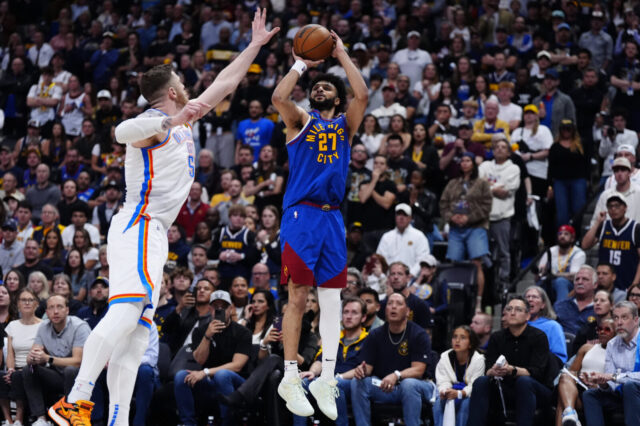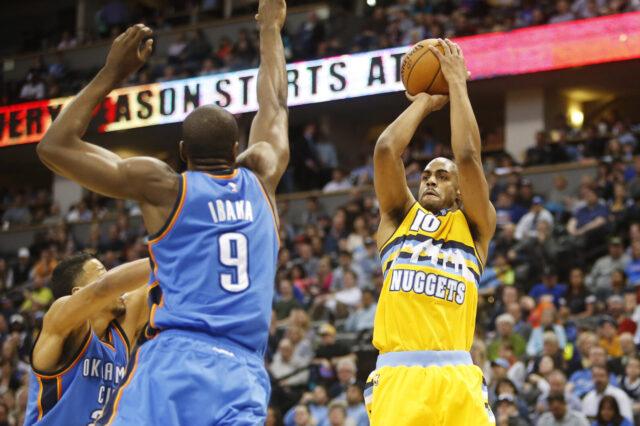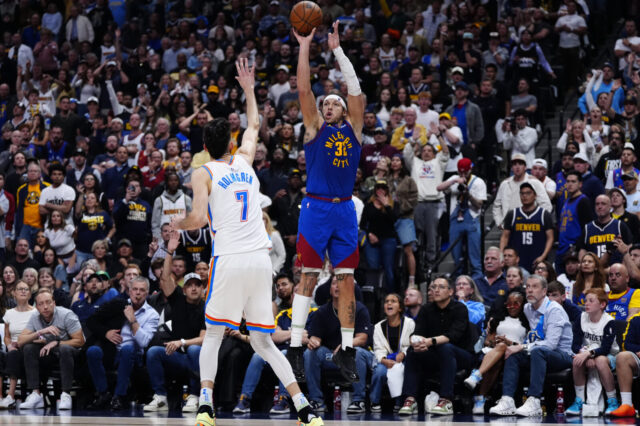Happy Hump Day! Thanks to everyone who contributed to the mailbag this week. There will be more in subsequent weeks as well, so if you have a question, comment down below or ask me on Twitter.
Let’s get into it.
This is a great over/under line for Michael Porter Jr. due to the obvious injury concerns, but I’m going OVER and here’s why:
The Nuggets have decided to hype up Porter quite a bit during the last several months for the work he is doing behind the scenes. Almost every word coming from the Nuggets organization, national reporters with connections, and other tidbits of discussion centers around Porter as a blue chip prospect regaining his form. And what’s not to like about a 6’10 forward with the size to shoot over smaller players and the agility/skill to maneuver past larger ones? Very few forwards in the NBA possess that combination of skills that can also perform at an efficient level.
I’m calling my shot a little bit here, but I think Porter is healthy and ready to go when the regular season rolls around. The Nuggets will certainly manage his minutes; there will be discussion about load management preventing him from playing back-to-backs or any time when his body is in less than optimal condition. But unless he sustains an ankle sprain or some new injury, I think he plays in between 60 and 70 games next year, averaging roughly 15 minutes per game in October and over 20 minutes per game by April.
The Nuggets will play him. They have to. If he’s anything close to the projected ceiling, then he has to play through his mistakes, learn on the fly, and develop chemistry with other members of Denver’s rotation. As a small forward, he will provide a great receiving option for Denver’s quarterback in Nikola Jokic, and cuts, outlet passes, and perimeter jumpers will be an easy way for Porter to make a tangible impact in his first professional season.
97 overall. Adam, the Arvydas Sabonis in his Soviet Union prime of pickup basketball, usually picks apart defenses strategically but can always fall back on the fact that he’s taller than everyone. Adam is 6’6, and the average height of most recreational players has to be somewhere around 6’0. On top of that, Adam played college ball, and most any college player can walk onto the local rec. league court and dominate the games for that day.
Definitely NOT crazy, and Michael Malone, at least when the going got tough in the playoffs, definitely agreed with you. Torrey Craig provides a different dynamic than any of Denver’s other options starting at small forward in that he can help cover for the lack of size with Gary Harris defending some wings and the lack of execution with Jamal Murray defending guards. As long as Craig is hitting his open threes on the other end to keep opposing defenses honest, then he deserves to see the floor, maybe even as the starter at small forward.
There are a variety of dynamics that make it difficult to start Craig that are laced throughout the rotation and possibly off the court. Will Barton was given a contract and promised the first look at the starting lineup during the 2018 offseason. Taking away his starting spot a year later (and then possibly benching him altogether for a rookie in Michael Porter Jr.) would be a tough sell in the locker room in keeping everyone united. Malone could certainly make it happen and smooth things over, but it’s a difficult proposition.
Porter likely isn’t ready to start, but he does need time, so that either leaves Barton as the starter and Craig out of the rotation or one of Barton/Craig replacing Malik Beasley as the backup shooting guard. This isn’t a crazy scenario either, but it’s not a scenario I’d consider given Beasley’s strong 2018-19 season.
That leaves Craig out of the rotation altogether, even if he is the best option to start. I don’t think he’s the best option and would actually prefer Barton or Juancho Hernangomez to start, but the point is: there is no easy solution to Denver’s small forward dilemma. This is why a trade feels inevitable, either for a better option or to condense the rotation.
Let’s answer the second question first: Denver will have five uniforms to select from during the 2019-20 season, six if they play a Christmas game. The previous four uniforms could be adopted to the upcoming season, and I expect Denver’s Association and Icon jerseys to be retained with new Statement and City editions to be introduced sometime before the regular season. The fifth jersey is the “Earned” jersey that is released to the 16 teams that made the playoffs. I’d expect that trend to continue this year just as it did following the 2017-18 playoffs.
As for a power ranking of the top Denver Nuggets uniforms, here are my top five:
1. Rainbow Skyline – 1980’s
This content is no longer available.
It’s hard to beat the classics. This jersey aged like fine wine, and it represents the most successful era of Nuggets history. That holds merit.
2. Classic Blues – Late 1970’s
This content is no longer available.
I enjoy the block lettering of these jerseys. It’s unique, pops really well, and represents David Thompson well. He was one of the best players in the NBA for nearly the entire existence of these jerseys, and the Nuggets enjoyed some of their greatest success in the late 70’s.
3. Maroon and Navy – 1990’s
This content is no longer available.
A strong uniform for the era that saw the Nuggets become the first 8-seed to defeat a 1-seed in the NBA playoffs. The lettering pops well, and the color contrast on both home and away uniforms made for a clean look.
4. New Age Skyline – 2018-19
This content is no longer available.
A controversial pick but definitely the one I prefer: the rainbow skyline jerseys from this past season were clean, colorful, and iconic. It would be great for Denver to adopt these jerseys into their standard home/away rotation, creating either a royal or navy blue option to match.
5. Navy Alternates – Mid to Late 2000’s
This content is no longer available.
This look was great because it incorporated Denver’s powder blue as an accent, as it should have always been, rather than the primary color. Navy with gold lettering and the powder blue trim was an excellent combination and iconic for Denver’s run with Carmelo Anthony. When I think of Chauncey Billups and his time in Denver, this is the jersey I picture, and that’s a great period to remember for Nuggets fans.
The short answer is no. Denver’s true success will occur in the continued development of their core pieces and playoff success.
The longer answer is that there are many ways to evaluate success and failure in the NBA. If only one team can win the trophy at the end of the year, are the other 29 teams failures? Of course not. At least not in this writer’s opinion. Success occurs relative to expectation. If Denver won 58 games on the back of an MVP caliber season from Nikola Jokic and lost in the first round, that would be a tough way to go. If they won 54 games but Murray looked like the newest star in the NBA and the Nuggets made the Western Conference Finals, that’s a win in my book. If Michael Porter Jr. appeared to be a star in the making but the Nuggets only won 50 games because Nikola Jokic broke a bone midway through the year (knock on wood) it’s tough to evaluate them one way or the other.
Assuming normal health and a similar output from players and end-of-season outcome, it wouldn’t be a failure. It probably wouldn’t be considered successful, but there are worse places to be.
I have long thought that Bradley Beal of the Washington Wizards makes the most sense. The Nuggets are one of the only teams with assets to acquire him, and it has been undersold just how impactful he would be on Denver’s offense. Sharing ball handling responsibilities would allow Jamal Murray to get back to what makes him efficient while continuing to grow as a scorer and playmaker. In a playoff setting, Beal’s playmaking for himself and others would help Denver in minutes when Nikola Jokic needs to rest.
Only six players in the NBA produced a per game stat line of 25 points, 5 assists, and 5 rebounds every night:
- Giannis Antetokounmpo – MVP
- James Harden – MVP runner-up
- Kevin Durant – Possible best player in NBA
- Stephen Curry – Ditto
- LeBron James – Ditto
- Bradley Beal
Nuggets fans may be cautious about giving up too many assets for Beal, but they must understand how strongly a player of his skill set would perform with Jokic and how much he would elevate Denver’s bench units when the going got tough. Adding talent that fits well helps win championships.
The simplest way to accomplish the deal would be to send Gary Harris, Michael Porter Jr., and one of Will Barton, Malik Beasley, Torrey Craig, or Juancho Hernangomez to Washington for Beal. No team can beat that package without the Boston Celtics including Jayson Tatum, and the Nuggets have the wing depth to make the trade work.
You asked for realistic, and I actually think this is. Denver is coming to a crossroads with their roster with so many talented pieces. There probably needs to be a move in the near future, and Beal just turned down an extension from the Wizards. Very few young players in the NBA come available the way Beal is about to move. Denver could be the team to capitalize, and if the Nuggets view themselves as one Bradley Beal away from a title shot, then they could do it.


